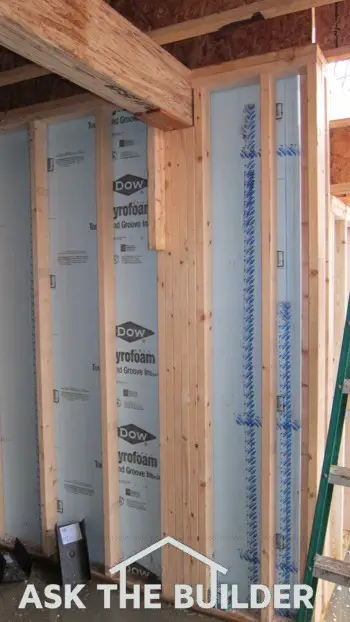Wood I-Beam Tips
DEAR TIM: I’m getting ready to build a large room addition that needs a beam to support the floor joists. I’ve been told that a wood beam will work, but I’ve always seen steel I-beams in other houses. Is it possible for wood to do the job? What are some of the pros and cons of wood I beams vs. steel? If you were building, would you use wood or steel? I don’t want to make a mistake on such a critical structural element. Peter L., White Plains, NY
DEAR PETER: Oh gosh, there’s no easy answer for you. The long and short of it is both wood and steel can make fabulous load carrying beams. I’ve used both materials for decades in all sorts of situations. In fact, you may not realize this, but you can mix the two making a hybrid beam of wood and steel.

You can see two different types of wood I beams in this photo. The large beam at the top is supporting smaller wood I joists or beams. Photo Credit: Tim Carter
First let me tell you that I’m not a structural engineer, but I’ve worked with many and installed the beams they’ve designed. The good news is both wood and steel can be used to carry tremendous concentrated loads.
In the last house I built, I had two wood beams in one wall that supported tons and tons of weight. In the basement of the same house, I had large steel I-beams that spanned nearly 16 feet supporting enormous loads as well. The use of steel allowed me to create wide-open spaces with minimal support columns.
That’s one advantage of steel over wood when you’re working with materials that are roughly the same size. Steel is so much stronger than wood pound for pound.
What’s fascinating is to see the evolution of engineered wood beams over the past forty years. Laminated beams, microlams, etc. are very common now, but I clearly remember when they were brand new to the block. It’s not uncommon to find laminated beams on an ordinary residential home in today’s marketplace.
Go back in time and look at old barn’s and other buildings built using the post and beam method and you’ll see wood beams made from one solid piece of timber. Perhaps the strongest wood beams made this way are Douglas Fir. There may be a stronger wood, but I’m not aware of it.
Today, lumber mills make beams like they make plywood. They basically use layers of solid wood that are glued together to make incredibly strong structural engineered timbers.
Keep in mind there are few cons to either of the materials. I say this because you can usually have an engineer come up with a wood beam that can replace a steel one. It’s all a matter of cost and the finished dimensions of the material.
If you want to think of worst-case scenarios, think about the things that attack and weaken the beams. Water can rust steel and rot wood. You can paint the steel beams with a metal primer and finish coat of paint to build water resistance. You can also have steel beams galvanized. Wood beams can be treated with borate chemicals to minimize wood rot and prevent infestation by wood-destroying insects that can’t harm steel.
If you want to fasten something to a steel beam, it’s a little bit of a challenge. You can easily nail into a wood beam or drill through it properly to install a bolt.
Fire is a danger to both materials. You can wrap a wood beam with fire-resistant drywall to protect it and commercial fire protectants can be sprayed on steel I-beams. You can also wrap a steel beam with the special drywall to buy time in a fire. Heat from a fire can weaken a steel beam turning it into soft taffy.
Keep in mind you can create a hybrid beam using a steel flitch plate that’s sandwiched between two regular pieces of wood framing material. The flat steel plate usually has staggered holes punched in it and you bolt the wood and steel together to create a super-strong beam that might carry a load 4 or 5 times greater than what the wood have done in the same space.
Homeowners or DIY'rs that are not familiar with working with beams often underestimate the weight of the beam and the importance of the support columns. Lifting a beam is often the work of two or three people and the combined weight of the workers and the beam can collapse ordinary step ladders resulting in serious injuries. The columns that support the beams must be rated to hold the weight and they must be connected properly to the beams.
What’s more, you need solid bearing from the bottom of the column to the earth. This pathway can be two or more stories in a house and over a hundred stories in a commercial building. At some point, the weight of the beams and the weight on the beam must be transferred to solid ground.
You can watch a wood beam video and read past columns about different structural issues. Just type “wood beam video” into the AsktheBuilder.com search engine.
Column 924
5 Responses to Wood I-Beam Tips